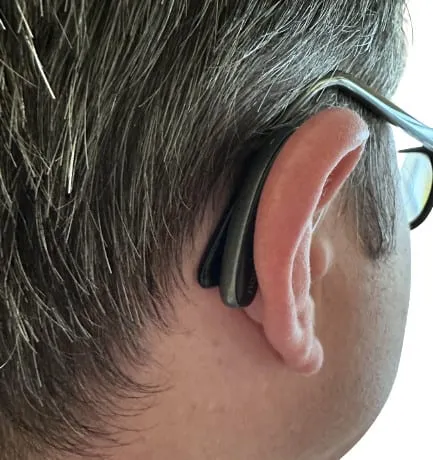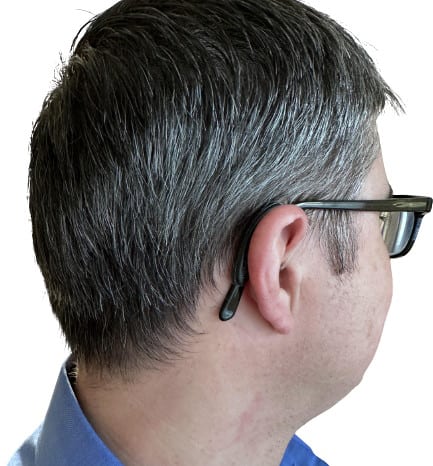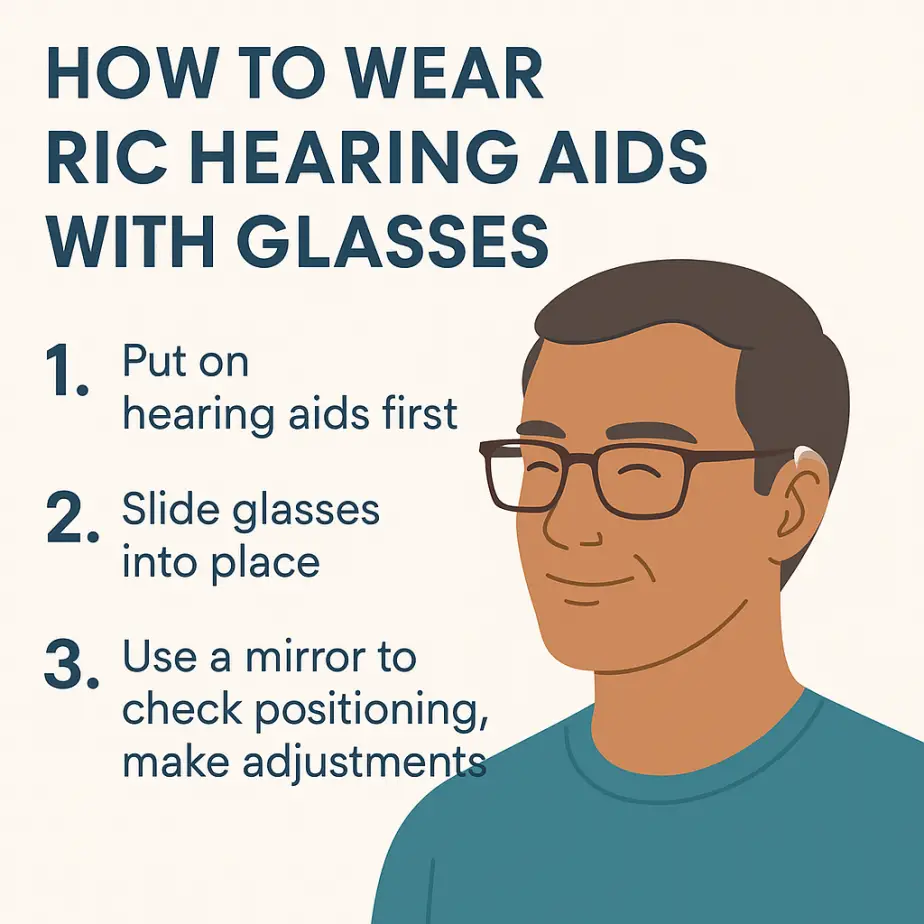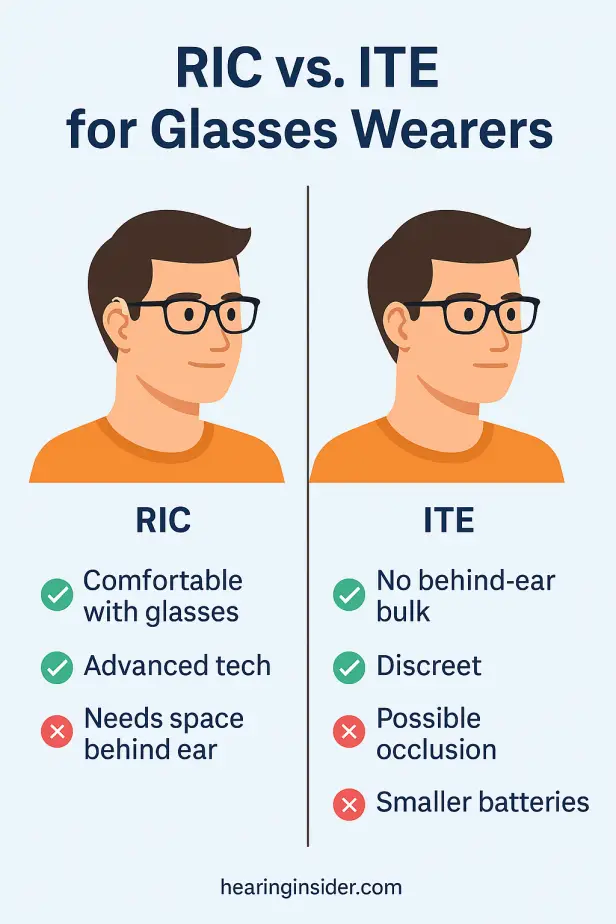Hearing loss affects more than 466 million people worldwide (WHO), and for many, hearing aids are life-changing tools that restore communication and confidence. At the same time, nearly two-thirds of adults over age 60 wear glasses, which means a large portion of hearing aid users face the same question:
How do you comfortably wear hearing aids with glasses?
The good news: modern designs—especially Receiver-in-Canal (RIC) devices—are engineered to work seamlessly with eyewear. And if RICs aren’t the right fit, several in-the-ear options can provide excellent alternatives.
As an audiologist with over a decade of experience fitting thousands of patients, I can confidently say this is a problem with straightforward solutions. Let’s walk through them.

Why RIC Hearing Aids Work Well with Glasses

RIC hearing aids have become the most popular style worldwide—and for good reason. The main device rests discreetly behind the ear, while a thin wire connects to a receiver placed inside the ear canal. This setup provides:
- ✅ Comfort and discretion – The slim profile fits alongside glasses without creating bulk.
- ✅ Strong performance – Suitable for mild to profound hearing loss, with advanced sound processing.
- ✅ Latest technology – RICs are often the first to receive upgrades such as Bluetooth streaming, rechargeability, and AI-powered features.
For glasses wearers, the advantage is that the lightweight design rarely causes interference. You may hear a slight “tap” when sliding glasses on, but most patients adapt quickly and don’t find it bothersome.
💡 Want to go deeper? If you’re exploring hearing aids for the first time or want to understand all your options, check out my comprehensive guide: Everything to Know About Hearing Aids. It covers styles, features, costs, and expert tips to help you choose the perfect fit.
Benefits of RICs for People Who Wear Glasses
From both patient feedback and clinical experience, here are the top reasons glasses wearers prefer RICs over traditional behind-the-ear (BTE) models:
- Smaller and lighter – Easier to position behind the ear without bumping into eyeglass arms.
- Customizable fit – Can be tailored to individual ear shapes and sensitivities.
- Minimal interference – Glasses arms rest comfortably above the device once positioned correctly.
- Discreet style – Available in multiple colors to blend with hair or skin tone.
👉 Pro Tip: Always put on your hearing aids first, then slide your glasses into place. This prevents glasses from dislodging the devices.
How to Wear Glasses with RIC or BTE Hearing Aids

Wearing both comfortably comes down to proper placement and practice.
- Insert hearing aids first. Position them securely behind your ears.
- Slide glasses into place. Rest the arms gently above the hearing aids.
- Practice the motion. With repetition, this becomes automatic.
If you’re just starting, use a mirror to check positioning. Over time, your hands will naturally find the correct placement.

What to Do If You Feel Discomfort
Even with proper placement, some glasses wearers may notice pressure behind the ears or find that their glasses arms push against the hearing aids. If this happens:
- 👓 Visit your optometrist – Glasses can often be adjusted by extending the arms or changing their angle.
- 👂 Ask your audiologist – A minor adjustment in tubing, receiver length, or earmold can relieve pressure.
- 🔄 Consider thinner glasses frames – Switching to slimmer arms can make a big difference in comfort.
👉 If problems persist, it may be time to explore in-the-ear hearing aid styles.
Hearing Aid Styles for Glasses Wearers

Hearing aids come in a variety of designs, and not all sit behind the ear. For people with thicker glasses or multiple behind-the-ear devices (oxygen tubing, masks, etc.), in-the-ear options can free up space.
Styles to consider:
- ITE (In-The-Ear): Full shell devices that sit inside the ear. Easier to handle but can feel “plugged.”
- ITC (In-The-Canal): Smaller and more discreet, though may be challenging for those with dexterity issues.
- CIC/IIC (Completely-In-Canal / Invisible-In-Canal): Nearly invisible but not suitable for all hearing losses.
While these eliminate behind-the-ear bulk, they may introduce other challenges like occlusion (a blocked-ear sensation) or slightly higher repair rates. This is why RICs remain the most popular choice, offering the best balance of comfort, power, and advanced features.
👉 Pro tip: Always purchase hearing aids first, then choose glasses that fit comfortably with them. Glasses are more affordable to replace, while hearing aids are a long-term investment in your hearing health.
When to Consider In-The-Ear Options
In my clinical practice, about 30–40% of hearing aid patients also wear glasses. Of these, only about 1% report ongoing interference between the two devices. Still, for those in that 1%, ITE or IIC hearing aids can be a better match.
Consider in-the-ear hearing aids if you:
- Wear thick-framed glasses that constantly bump your aids.
- Use oxygen cannulas or masks that compete for space behind your ears.
- Have sensitive skin or pressure points that make BTE/RIC devices uncomfortable.
Trial periods exist for a reason—don’t hesitate to return and try a different style if your current setup isn’t working.
Final Thoughts: Glasses and Hearing Aids Can Work Together
Wearing hearing aids with glasses may feel tricky at first, but for most people, it’s not a deal-breaker. With today’s lightweight RIC designs, you can enjoy clear hearing and comfortable eyewear at the same time.
If space behind your ears is limited, in-the-ear hearing aids provide effective alternatives. The key is working closely with a qualified audiologist who can help you find the right fit for your hearing needs, lifestyle, and comfort preferences.
Remember:
- Start with RICs if possible—they’re the most versatile and glasses-friendly.
- Use trial periods to test comfort.
- Don’t hesitate to adjust your glasses or swap styles if needed.
🎯 Bottom line: With the right combination, hearing aids and glasses can absolutely work together to give you the best of both worlds—clear vision and clear hearing.
👵👴 Considering hearing aids for yourself or a loved one? Glasses are common among older adults, and choosing the right device makes a big difference. For tailored recommendations, see my updated guide on the Best Hearing Aids for Seniors.

